Chè Thái (Vietnamese Fruit Cocktail)
Che Thai, also known as Vietnamese Fruit Cocktail, is a vibrant Vietnamese dessert that combines fresh (or canned) fruits, jelly, tapioca pearls, and creamy coconut milk. It is such a versatile and easy-to-make dessert, using whatever ingredients you have on hand.
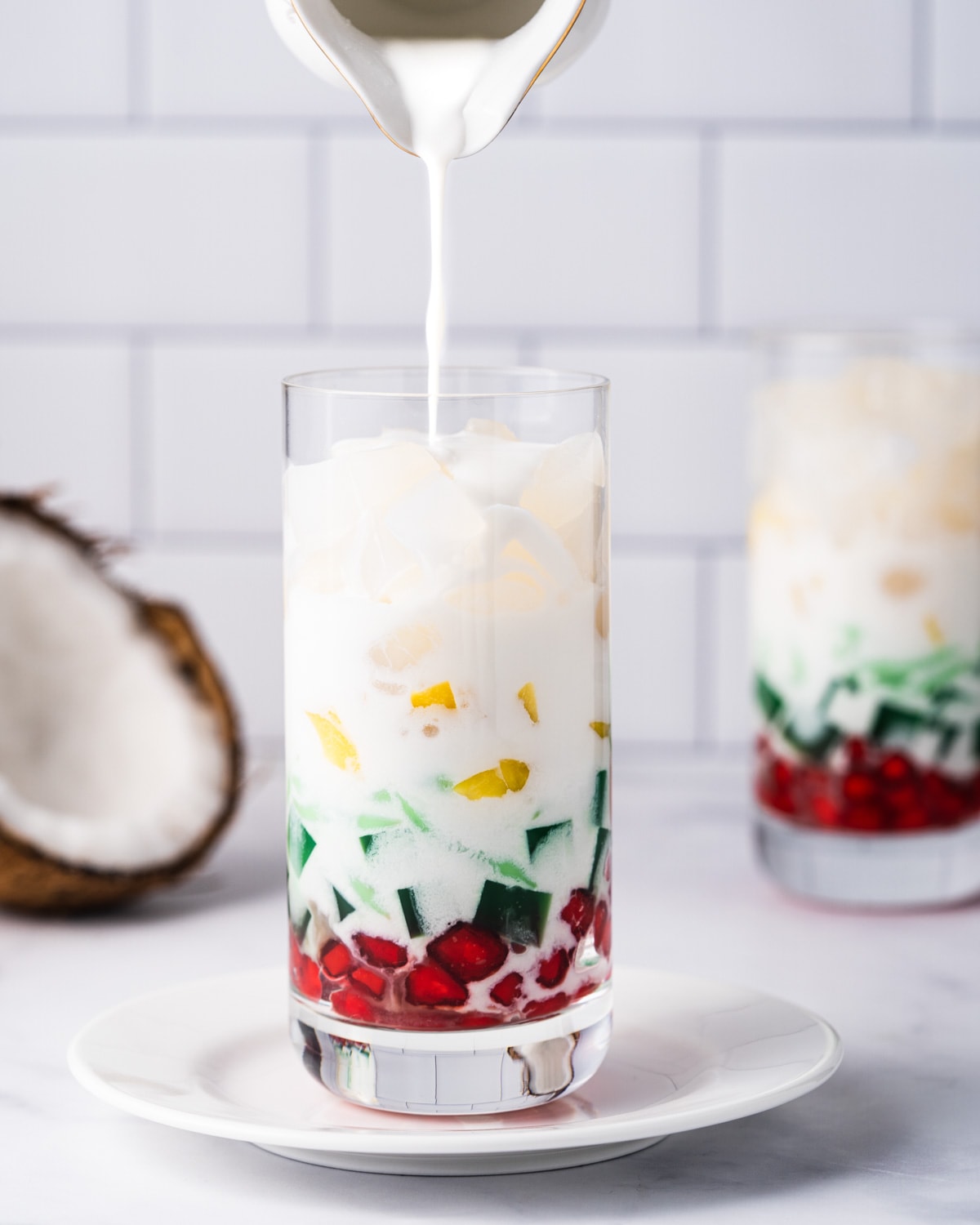
It is an affordable and refreshing dessert that has no set list of ingredients, which means that recipes can vary a lot. This recipe is the ultimate guide to everything you can possibly put into the dessert. Feel free to use whatever you have on hand or omit anything you don’t like. What’s great about this Che Thai recipe is that it can be made in minutes.
If you’re looking for other Vietnamese desserts, check out this three layer dessert, che ba mau or this creamy coconut tapioca banana pudding, che chuoi.
What is Che Thai?
Che Thai is a popular Vietnamese dessert that typically consists of a sweet soup or pudding made with coconut milk, mixed with various colorful fruits and chewy jelly, and sweetened with sugar. The fruit mix usually includes items like jackfruit, longan, lychee, coconut, and other tropical fruits. Che Thai is served chilled and garnished with shaved ice. It’s a refreshing and sweet treat that’s popular in Vietnam.

Origin
Che Thai is a delicious and refreshing dessert originating from Vietnam. It is made with a wide variety of colorful ingredients, such as tropical fruits and various types of jelly, all mixed together with coconut milk and crushed ice to create a creamy, sweet, and slightly chewy dessert.
The dessert is believed to have originated from the southern region of Vietnam, where the abundance of tropical fruits and coconut cultivation led to the creation of this dessert. The name “Che Thai” means Thai-style sweet soup, but it is not related to the cuisine of Thailand. Instead, it exemplifies the diverse cultural influences that have shaped Vietnamese cuisine over the centuries.
The name “Thai” in Che Thai may be misleading, as the dessert does not have origins in Thailand. The name “Thai” refers to the bright and colorful ingredients often used in the dessert, as these are reminiscent of Thai cuisine. Some might say it resembles a Thai dessert called “Tub Tim Krop,” which has water chestnuts and coconut milk. In Vietnam, Che Thai is commonly sold by street vendors and is enjoyed by locals and visitors alike as a refreshing and sweet treat.
Che Thai is typically served in a tall glass, making it perfect for hot and humid summers when people need a refreshing and cool dessert. Its bright, colorful appearance and sweet, creamy flavor make it a popular Vietnamese dessert. It is also super versatile, as different ingredients can be added or omitted to suit personal preferences.
Why You’ll Love It
- Customizable: You do not need to add everything listed in the ingredients. Just add and omit anything you’d like.
- Easy to make: If you choose not to make some of the ingredients from scratch, it is as simple as opening a few cans of fruits and jelly. This is a no-bake dessert.
- Make this ahead of time for easy entertaining: It makes a huge batch, and it’s great for parties and get togethers.
- Healthy: You can control what goes into it. To make it healthy, use fresh seasonal fruits, adjust the amount of sugar, or use a natural sweetener.
- Kid Friendly: It’s fun, colorful, and tasty.
Kitchen Tools
- Saucepan
- Small pot
- Measuring cups and spoons
- Fine mesh strainer
- Potato Ricer – If you plan to make the pandan worm-shaped jelly (banh lot), there are 3 options: a potato ricer with a coarse disc, a stainless steel colander with large holes, or a stainless steel slotted spoon (you’ll want to avoid plastic since the banh lot batter will be hot and it might melt the plastic).
Ingredients Needed
This will seem like a long list of ingredients, but this is an ultimate list of everything you can put into che thai. Feel free to substitute or omit based on what you have on hand or your personal taste preference.
Please scroll ⬇️ to the recipe card to see the full ingredient amounts and instructions.
It starts with a base of milk such as whole milk, heavy cream, half and half, coconut milk, coffee creamer, or a mixture of any of them. Every family has their own version. Feel free to experiment and see what you like. To make it dairy-free, use coconut milk or lactose-free half and half.

The “red rubies” or sương sa hạt lựu are made of water chestnuts, red food coloring, and tapioca starch. They’re supposed to imitate pomegranate seeds. I prefer using canned whole water chestnuts rather than sliced ones because the whole ones retain less water from the canned preservatives. If you can’t find water chestnuts, use apple, pear, or jicama.

The pandan agar agar jelly is made from water, agar agar powder, pandan extract, and sugar. I prefer the Telephone brand agar agar powder and Butterfly brand pandan extract. Both can be found at your local Asian grocery store or on Amazon. You can even use an agar agar substitute such as gelatin.

Pandan worm-like jelly or banh lot is made of mung bean starch, tapioca starch, water, and pandan extract. You will need a potato ricer to create the worm-like shape.
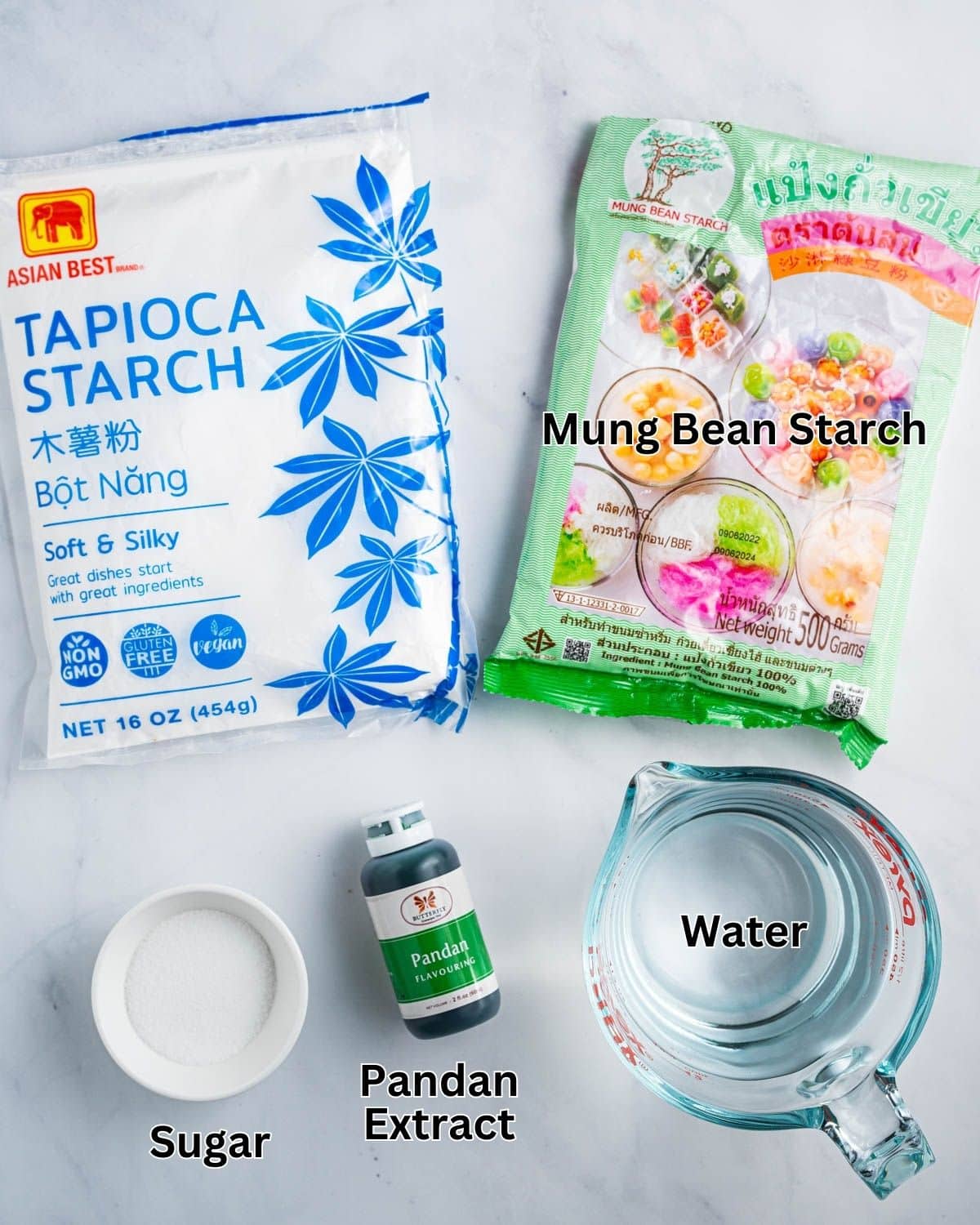
Use canned fruits such as jackfruit, lychee, longan, toddy palm seed, and coconut jelly (nata de coco), or substitute them with any fresh seasonal fruits such as dragon fruit, jackfruit, lychee, longan, coconut, mango, and durian. Save the juice from the canned lychee to flavor the dessert. Drain all of the other canned fruits and jelly.

Variations and Substitutions
- Instead of “red rubies,” use fresh pomegranate seeds.
- Instead of red food dye for the red rubies, use beet juice, beet powder, pomegranate juice, or other natural food coloring.
- Instead of water chestnuts, use apple, pear, or jicama.
- Instead of pandan agar agar jelly, use canned ai yu jelly or grass jelly.
- Instead of canned fruits, use fresh fruits such as dragon fruit, jackfruit, lychee, longan, coconut, mango, and durian.
- Use coconut milk or cream or lactose-free half and half as the base for a dairy-free option.
- To take this dessert to the next level, substitute some of the half-and-half or coconut milk with French vanilla or Hazelnut coffee cream.
- Instead of sugar, sweeten it with condensed milk.
Let’s Make Some Che Thai!
“Red Rubies”


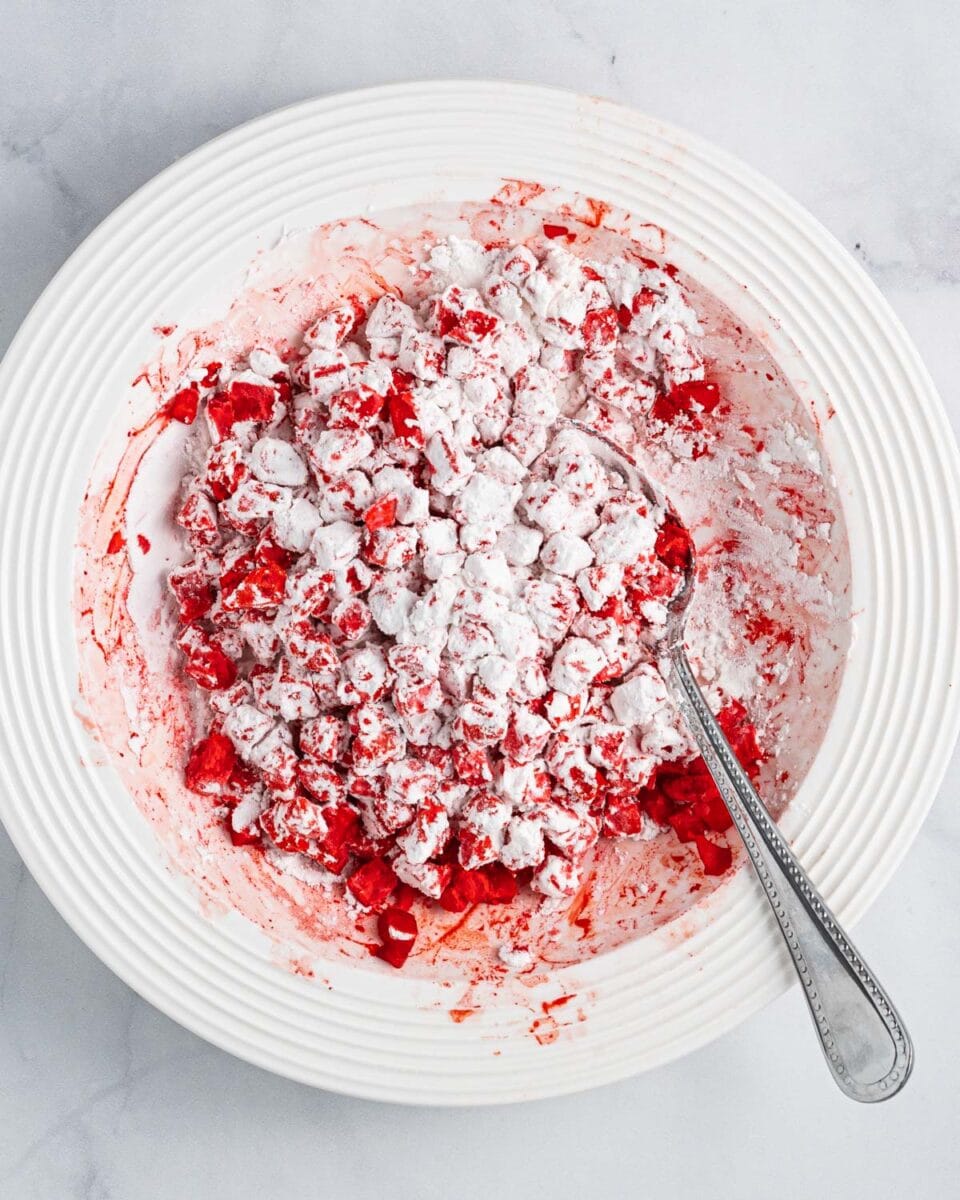


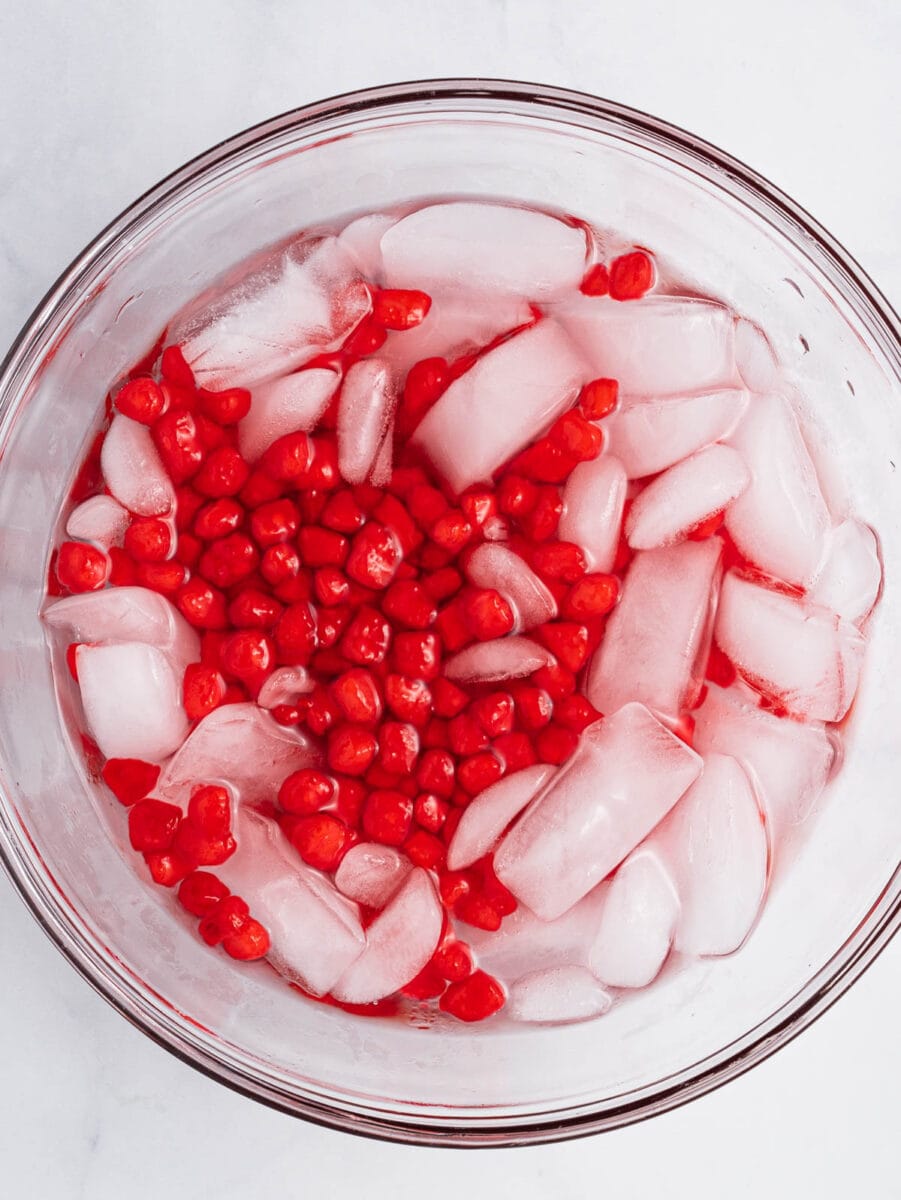
- Drain the water chestnuts completely from the can. Cut them into small cubes, about ¼ inches. Place them in a medium bowl and stir in 3 drops of red food dye. Toss until all the pieces are evenly coated.
- Add tapioca starch and stir to coat evenly. Sift any excess tapioca starch through a colander.
- In a small pot, bring 2-3 inches of water to a boil over medium-high heat. Add the chestnuts and give them a quick swirl to avoid clumping together. Cook for 2-3 minutes or until they float to the top.
- Once it is done cooking, use a slotted spoon to scoop it out and place it directly into a bowl of ice water. Give it a good stir. Let it cool in the ice bath for at least 10 minutes to prevent sticking.
Pandan Agar Agar Jelly

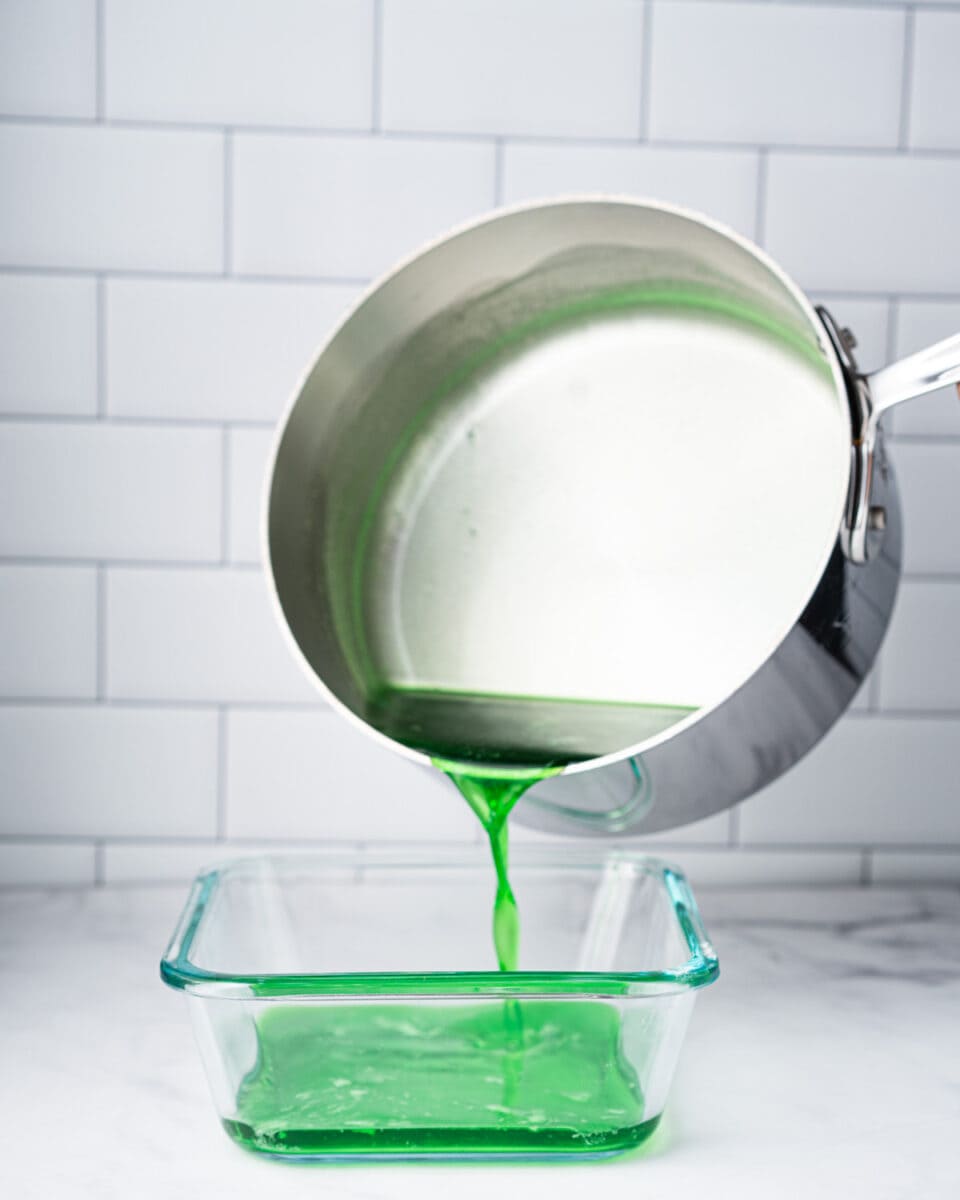
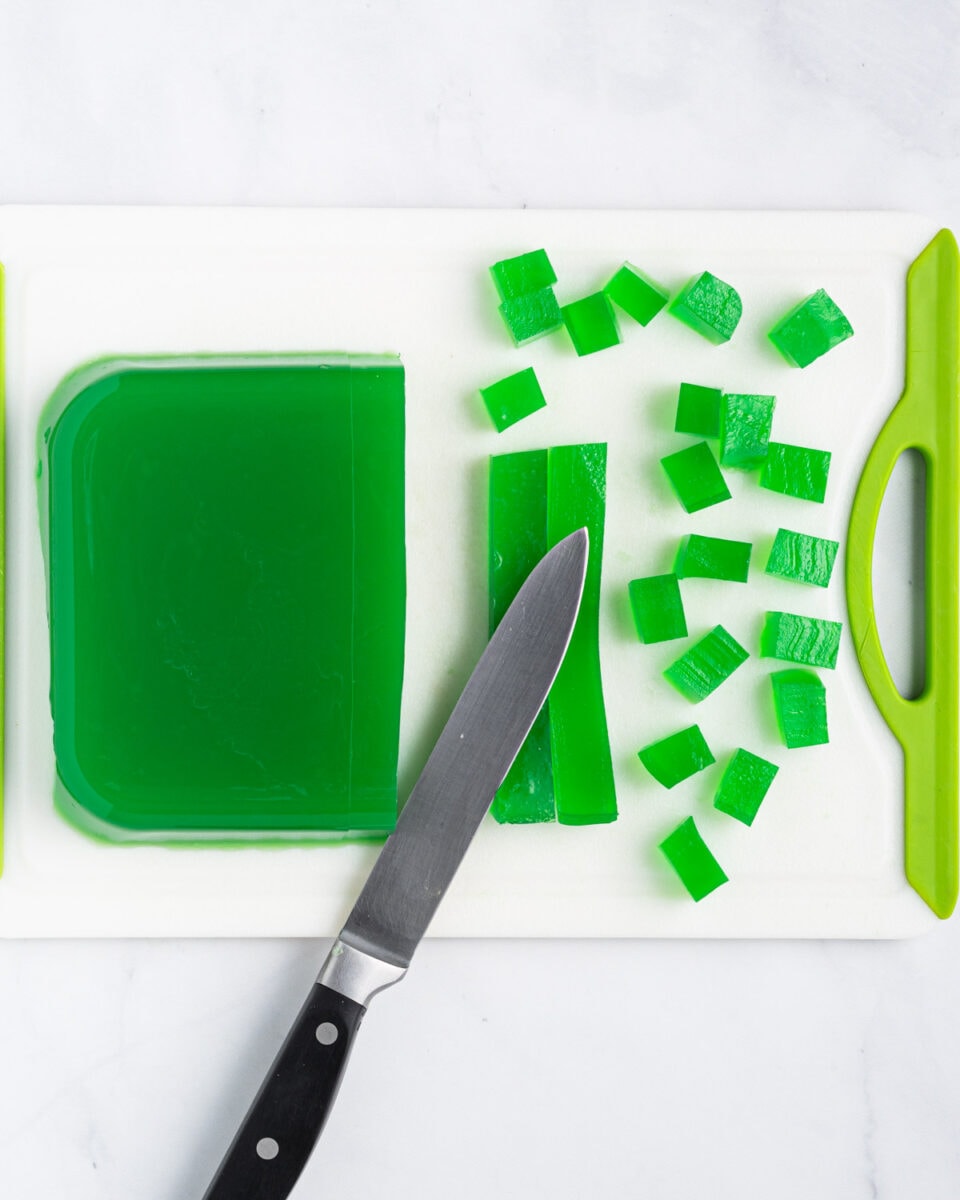
- In a small saucepan, whisk together water, agar agar powder, pandan extract, and sugar, and bring it to a boil. Reduce the heat and let it simmer until the agar agar and sugar are dissolved, about 6-7 minutes.
- Pour the mixture into a 4×4 pan or a glass container and let it cool in the fridge for at least 2 hours until chilled.
Pandan Worm-Like Jelly (Banh Lot)

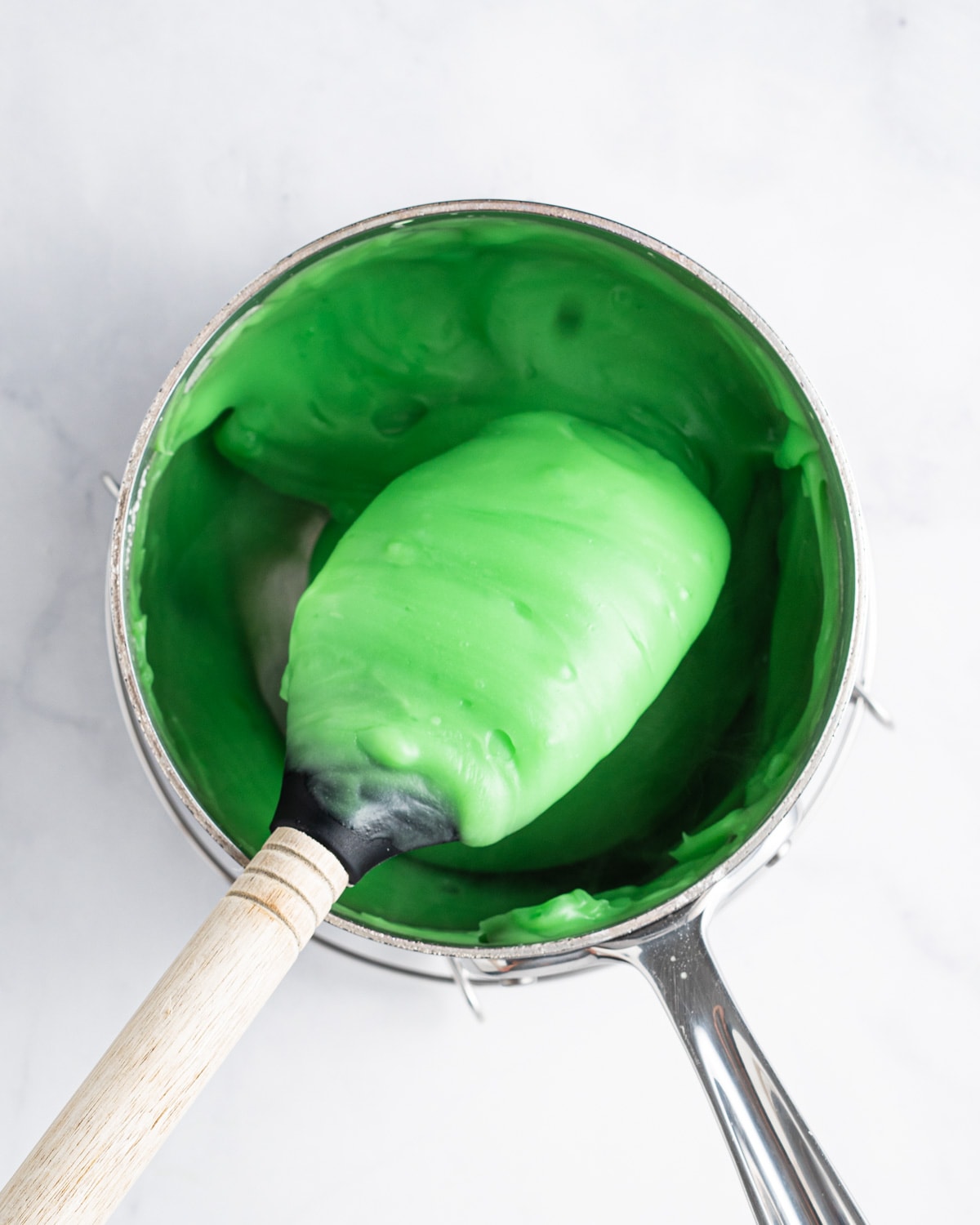
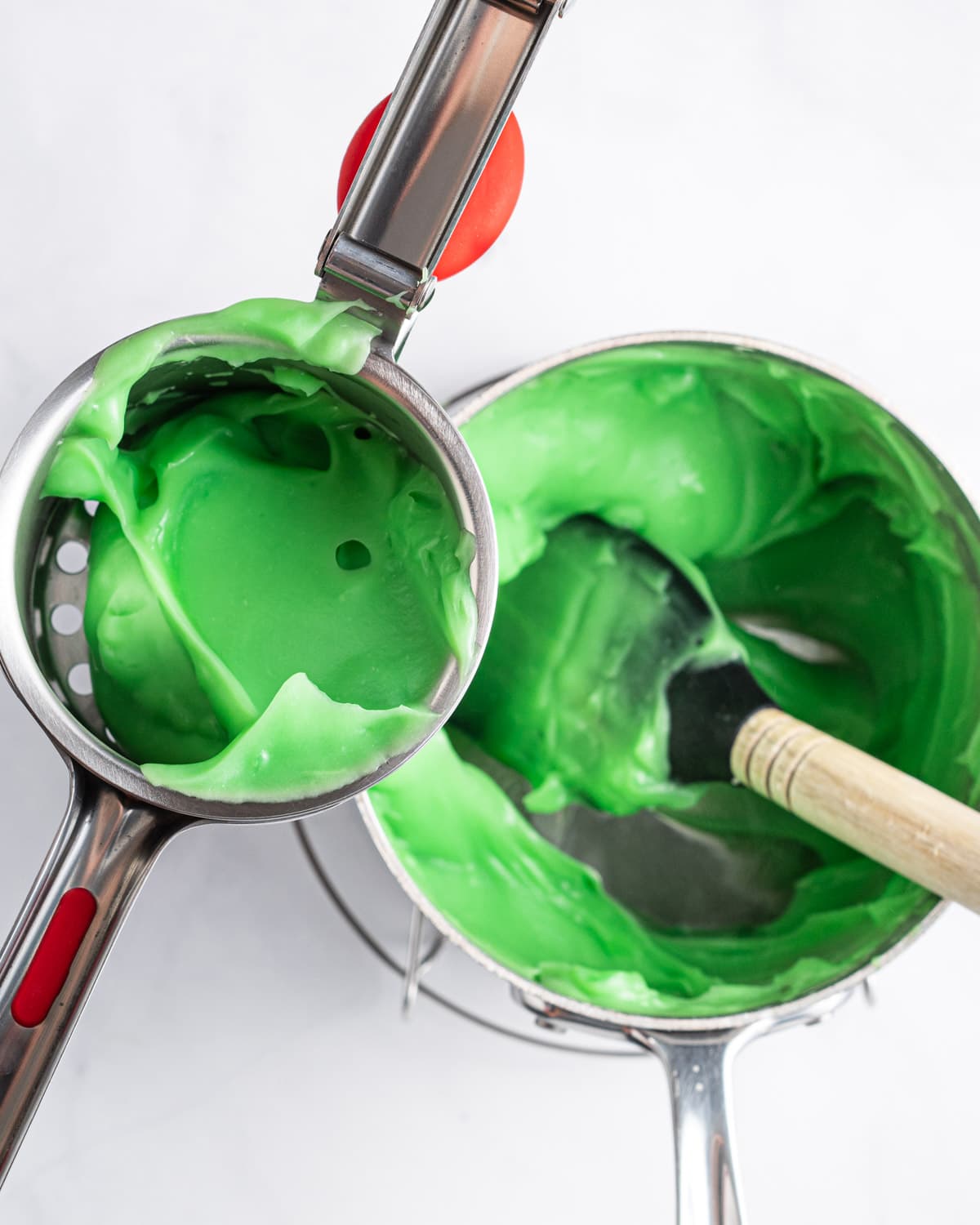


- Prepare a potato ricer with a coarse disc and a large ice water bath to be used after the pandan batter is ready.
- In a small saucepan, without turning on the heat, whisk together water, sugar, mung bean starch, tapioca starch, and pandan extract. Continue whisking vigorously to avoid clumps.
- Turn the heat to medium-high and continue whisking until the batter thickens, about 4-5 minutes. Then, turn off the heat.
- Working in batches, place the pandan batter into the potato ricer and press gently until 2-3 inch worm-like pandan droplets enter the ice bath. Repeat until the entire batter is used. For best results, let it cool in the ice bath for at least 10 minutes to prevent sticking.
Assembling the Che Thai

- If using coconut cream, add it to a small saucepan and heat it on medium-low heat. Bring it to a low simmer, but do not let it boil over. Add sugar and stir until it dissolves. Turn off the heat and set it aside to let it cool completely before adding it to the rest of the ingredients.
- In a large party punch bowl, add the half-and-half and coconut cream mixture (or coffee creamer) and stir in red rubies, pandan agar agar jelly, pandan worm-shaped jelly, jackfruit, lychee, longan, toddy palm, coconut jelly, and coconut.
Serve chilled or with crushed ice.

Tips for Red Rubies
– Completely drain and dry the water chestnuts with a paper towel. This will ensure that the tapioca starch sticks to the water chestnuts.
– Use a colander to sift the excess tapioca starch off.
– When adding it to boiling water, do not overcrowd it. Stir as you pour in the red rubies to prevent them from sticking together.
– Have the ice water bath ready before boiling. The red rubies only need to be cooked for 2-3 minutes, and then you will need to quickly submerge them in an ice water bath to cool them down.
– Let it cool in the ice water bath for at least 10 minutes to prevent them from sticking together.
Tip for Pandan Agar Agar Jelly
– The pandan jelly needs time to set. You may need to do this a day before making the che thai. It will need to cool in the fridge for at least 2 hours. If you don’t have time to make this. Try substituting it with ai yu jelly or grass jelly.
Tips for Pandan Worm-Shaped Jelly
– Before starting, prepare the potato ricer and ice bath. Quickly transfer the batter into the potato ricer before it cools down.
– It only takes a matter of seconds for the batter to go from raw to cooked, so do not leave it unattended.
– Use a rubber spatula to continuously stir and scrape the bottom of the pot to cook it evenly.
Tips for Assembling the Che Thai
– If you’re using coconut milk sauce, let it cool completely in the fridge before adding it to the che thai. You do not want to cook the fruits.
Cut the fruits beforehand and only add the milk mixture right before serving. This will keep it fresh for longer.

Frequently Asked Questions and Answers
Che Thai is a dessert that offers a unique combination of flavors. It has a sweet and refreshing taste with a tropical twist. The primary flavors come from the fruits used in the dish, which can vary but often include a mix of tropical fruits such as coconut, longan, lychees, and jackfruit. These fruits contribute a naturally sweet and juicy taste to the dessert.
Adding jelly and red rubies adds a pleasant, chewy texture to the dish. The jelly is usually made from agar-agar, a type of seaweed-derived gelatin, and can have a subtle floral or fruity flavor. On the other hand, red rubies provide a slightly gummy texture with a crunch in the middle from the water chestnut, adding an interesting contrast to the overall dessert.
To tie all the elements together, Che Thai is generously drizzled with sweetened coconut milk and half and half, imparting a rich flavor. The coconut milk adds creaminess and complements the fruity and chewy components of the dessert.
How to Store Leftovers
If you’ve ever made a batch of che thai and found yourself with leftovers, don’t worry! Proper storage can help ensure your dessert stays fresh and tasty for later consumption. The first step is to transfer the leftovers to an airtight container. This will help prevent any odors from seeping in and affecting the taste of your dessert.
Refrigerate
You can store your leftovers in the fridge if you plan on consuming them within a day or two. However, it’s important to note that che thai contains coconut milk, which can spoil quickly. For this reason, it’s best to consume the leftovers within 24 hours of storing them in the fridge.
Freeze
If you think you won’t be able to finish your che thai within a day or two, you can freeze it instead. This will extend its shelf life and allow you to enjoy it later. To freeze the leftovers, transfer them to a freezer-safe container and place them in the freezer. Be sure to label the container with the date to track how long it’s been frozen.
Defrost
Thaw it in the fridge overnight. Avoid thawing at room temperature, as this can lead to the growth of harmful bacteria. Once it’s thawed, give it a quick stir or mix to redistribute any ingredients that may have settled during freezing. It will have a slightly different texture than freshly made che thai, but it will still be just as tasty.
Fun Ways To Transform Leftover Che Thai
While this delightful dessert tends to disappear quickly, here are some creative suggestions to transform and enjoy any leftover portions (and make it last longer):
- Che Thai Popsicles: pour the leftovers into popsicle molds for a portable frozen treat.
- Che Thai Smoothies: blend the leftovers with ice cubes and a splash of milk or coconut water to create a refreshing and fruity smoothie. You can even add a banana or some fresh fruits for added flavor.
RECIPE

Che Thai (Vietnamese Fruit Cocktail)
Equipment
Ingredients
"Red Rubies"
- 1 (8 oz) can whole water chestnuts
- 3 drops red food coloring
- ⅔ cup tapioca starch
- water
Pandan Agar Agar Jelly
- 1¾ cups water
- 2 teaspoons agar agar powder (Telephone Brand)
- ½ teaspoon pandan extract
- 3 tablespoon granulated sugar
Pandan Worm-Shaped Jelly (Banh Lot)
- ⅔ cup mung bean starch
- 3 tablespoon tapioca starch
- 1 tablespoon sugar
- 3 cups water
- ½ teaspoon pandan extract
Canned Fruits
- 1 (20 oz) can jackfruit, drained and thinly sliced
- 1 (20 oz) can lychee and it's juice
- 1 (20 oz) can longan, drained
- 1 (18 oz) can toddy palm seed, drained
- 1 (12 oz) jar coconut jelly (coco de nata), drained
- fresh or canned coconut, cut into strips
Milk
- 1 cup half and half
- 1 cup coconut cream or coffee creamer (hazelnut or French vanilla) (use either one)
- ½ cup sugar
Instructions
"Red Rubies"
- Completely drain the water chestnuts from the can. Cut the water chestnuts into small cubes, about ¼ inch. Place it into a medium bowl and stir in 3 drops of red food dye. Toss until all the pieces are evenly coated.
- Add tapioca starch and stir to evenly coat. Remove any excess tapioca starch by using a colander to sift.
- In a small pot, bring 2-3 inches of water to a boil over medium-high heat. Add the chestnuts and give it a quick swirl to avoid them clumping together. Cook for 2-3 minutes, or until it floats to the top.
- Once it is done cooking, use a slotted spoon to scoop it out and place it directly into a bowl of ice water. Give it a good stir. Let it cool in the ice bath for at least 10 minutes, to prevent sticking.
Pandan Agar Agar Jelly
- In a small saucepan, whisk together water, agar agar powder, pandan extract, and sugar, and bring it to a boil. Reduce the heat and let it simmer until the agar agar and sugar are dissolved about 6-7 minutes.
- Pour the mixture into a 4×4 pan or a glass container and let it cool in the fridge for at least 2 hours until chilled.
Pandan Worm-Shaped Jelly (Banh Lot)
- Prepare a potato ricer with a coarse disc and a large ice water bath, to be used after the pandan batter is ready.
- In a small saucepan without turning on the heat, whisk together water, sugar, mung bean starch, tapioca starch, and pandan extract, continue whisking vigorously to avoid clumps.
- Turn the heat to medium-high and continue whisking until the batter thickens, about 4-5 minutes. Then, turn off the heat.
- Working in batches, place the pandan batter into the potato ricer and press gently until 2-3 inch worm-like pandan droplets enter the ice bath. Repeat until the entire batter is used.
Assembling Che Thai
- If using coconut cream, add it to a small saucepan and heat it on medium-low heat. Bring it to a low simmer, but do not let it boil over. Add sugar and stir until it dissolves. Turn off the heat and set it aside to let it cool completely before adding it to the rest of the ingredients.
- In a large party punch bowl, add half and half and coconut cream mixture (or coffee creamer) and stir in red rubies, pandan agar agar jelly, pandan worm-shaped jelly, jackfruit, lychee, longan, toddy palm, coconut jelly, and coconut.
Notes
Helpful Tips
Red Rubies
- Completely drain and dry the water chestnuts with a paper towel. This will ensure that the tapioca starch sticks to the water chestnuts.
- Use a colander to sift the excess tapioca starch off.
- When adding it to boiling water, do not overcrowd. Stir as you pour in the red rubies to prevent them from sticking together.
- Have the ice water bath ready before boiling. It only needs to cook for 2-3 minutes and you will need to quickly submerge the cooked red rubies into an ice water bath to cool it down.
- Let it cool in the ice water bath for at least 10 minutes to prevent them from sticking together.
Pandan Agar Agar Jelly
- The pandan jelly needs time to set. You may need to do this a day before making the che thai. It will need to cool in the fridge for at least 2 hours. If you don’t have time to make this. Try substituting it with ai yu jelly or grass jelly.
Pandan Worm-Shaped Jelly
- Have the potato ricer and ice bath ready before starting. You will need to quickly transfer the batter into the potato ricer before it cools down.
- It only takes a matter of seconds for the batter to go from raw to cooked so do not leave it unattended.
- Use a rubber spatula to continuously stir and scrape the bottom of the pot to cook it evenly.
Assembling the Che Thai
- If you’re using coconut milk sauce, let it cool completely in the fridge before adding it to the che thai. You do not want to cook the fruits.
- Cut the fruits ahead of time and only add the milk mixture right before serving. This will keep it fresh for longer.




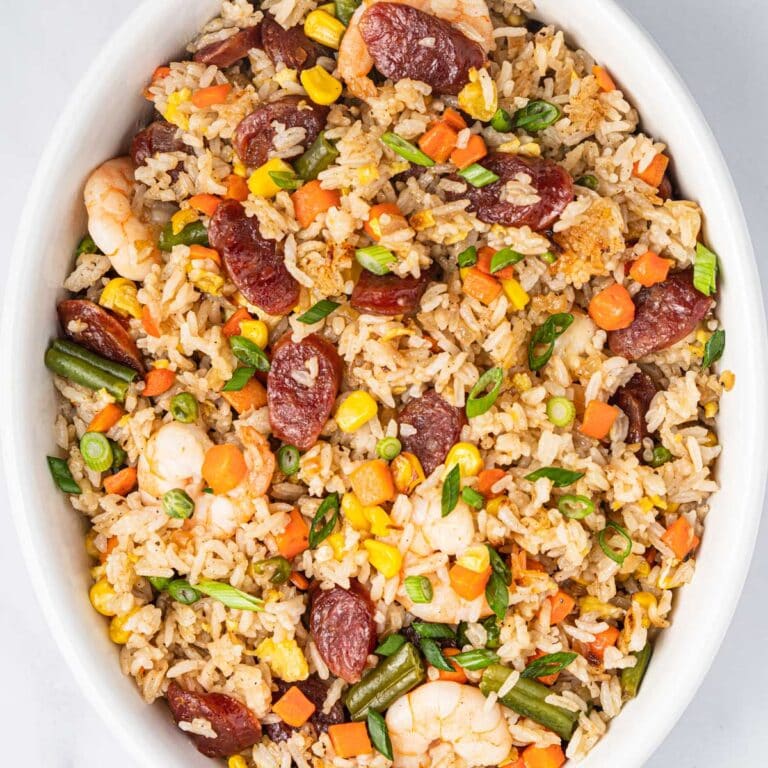


My favorite Vietnamese che but I’ve never made the red rubies before. I made this over the weekend for a party and it was a hit with the kids. Thanks for the recipe.
This was amazing and such a treat! Thank you! Everyone in my family loved it.
I’ve never had anything like this before! I love this sweet treat! Thanks for sharing!
What’s great about this Che Thai recipe is that it’s so versatile. I can use what I have on hand to make this sweet and refreshing dessert.
What a unique dessert! I like the flavor of coconut so I would love to give this a try and experiment with different combinations of jellies and fruits.
The mix of colors in this drink is gorgeous! I love that you have recipes for all the different types of jellies, can’t wait to try making this!